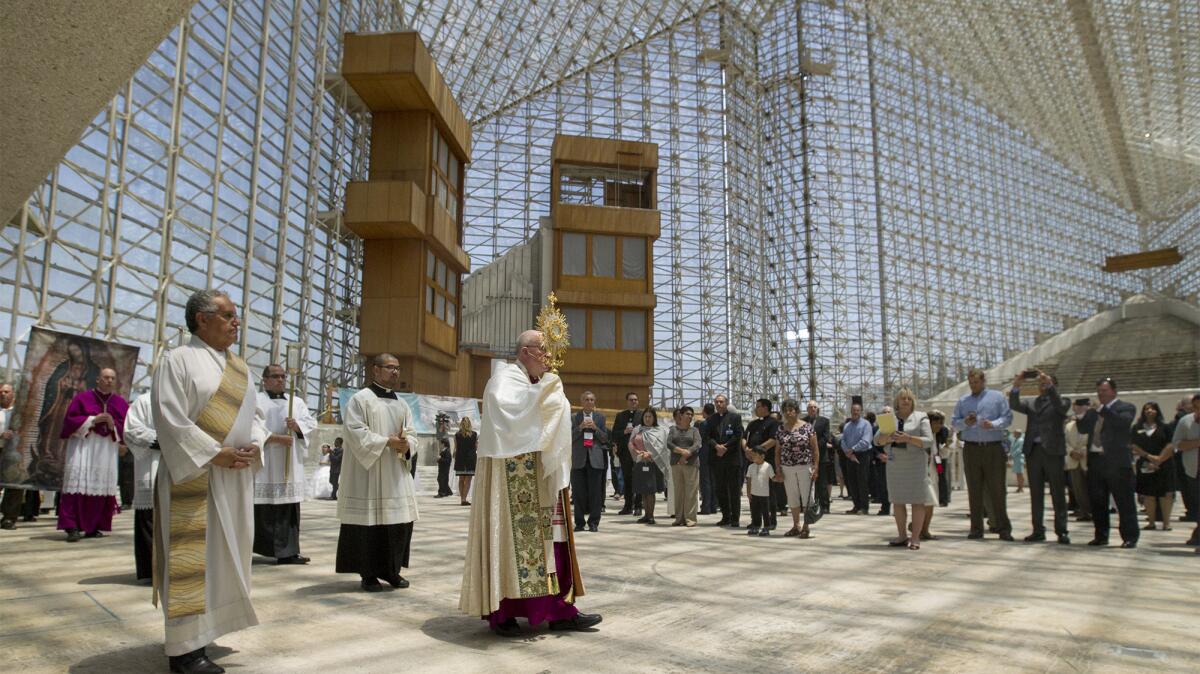Want to see the Catholic Church’s future? Go to Mass in the fast-growing Diocese of Orange
- Share via
On any given Sunday, the Garden Grove campus of Christ Cathedral — a postmodern glass structure accompanied by an 18-story stainless steel steeple that serves as the hub of Catholic life in Orange County — is a flurry of different languages.
A 6:15 a.m. Mass in Vietnamese is followed by a 7:45 a.m. Mass in Spanish, then ones in English, Chinese and Spanish again — and on throughout the day.
“One of the blessings is that it’s such a mix of all the different cultures here,” said Bishop Kevin Vann of the Roman Catholic Diocese of Orange. “It creates a healthy dynamism of energy and enthusiasm. One day I can go from Vietnamese to Spanish to English, and that really invigorates me — and I think it does for the whole diocese.”
This multiculturalism is one reason why, scholars say, during a time of priest shortages, parish closures and thinning ranks in the pews, the Diocese of Orange is now among the fastest-growing dioceses in the United States and home to 1.3 million Catholics.
“The cathedral reflects the diocese as a whole in terms of diversity and where it is now,” said Tarra McNally, assistant director of evaluation at the University of Southern California’s Center for Religion and Civic Culture. “If you look at the Diocese of Orange, that’s the future of the Catholic Church in the United States over the next 50 years.”
While the history of the Catholic Church in Orange County stretches back to 1776, when Spanish priests established Mission San Juan Capistrano to evangelize the native population, it wasn’t until two centuries later, in 1976, that the Diocese of Orange was officially formed by breaking away from the Archdiocese of Los Angeles.
The expansion of the diocese was immediate.
Orange County was in the midst of a post-World War II economic boom that increased the population from 130,000 in 1940 to 1.4 million by 1970, according to the U.S. Census, leading to a parallel swelling of the Catholic population.
Immigration from heavily Catholic countries — Mexico and Vietnam, in particular — further fueled Catholic growth from 330,000 in 1976 to 1.3 million today.
Father Tuyen Nguyen, pastor of Blessed Sacrament Catholic Church in Westminster, estimates that there are now as many as 70,000 Vietnamese Catholics in Orange County and 16 parishes — including his — that offer Mass in Vietnamese every week.
“It’s always crowded at the Vietnamese Mass,” he said.

But it’s not just external factors of immigration and population movement within the United States that propel the church’s growth, diocese officials said. It’s also the result of innovative strategies to maintain Catholicism’s vibrancy in the modern age.
At the founding of the diocese, for instance, the first bishop, William Johnson, took steps to prevent the community from self-separating along ethnic lines — something that was common among Catholics on the East Coast.
“Bishop Johnson really did not want to establish national parishes in Orange County,” said the Rev. Christopher Smith, rector and episcopal vicar of Christ Cathedral. “He didn’t want an all-Vietnamese parish or an all-Colombian parish. So our parishes are very multi-cultural and multi-national, so they have a different characteristic about them.”
To do this, Johnson had parishes offer Mass in several languages.
“Most of our parishes are multilingual, to try to have folks of different cultures pray together, worship together and interact with each other,” Vann said. “It really makes pastoral sense to me. It goes a long way to break down some of those barriers.”
Vann is fluent in Spanish and can conduct Mass in Vietnamese — “If I practice it, my Vietnamese secretary helps,” he said.
This strategy also keeps families together, Smith said, by offering immigrants and their English-speaking children and grandchildren services under the same roof.
In 2012, the diocese acquired Christ Cathedral, itself a symbol of the church’s growth that is in the midst of a $72.3-million renovation that will include shrines to Our Lady of La Vang, a Vietnamese Marian apparition, and the Virgin of Guadalupe, patron saint of the diocese and the Americas.
The project is expected to be completed in early 2019.
With the surrounding campus facilities, the diocese embarked on an ambitious programmatic expansion that now includes the largest Catholic newspaper in the country, published in English and Spanish with a circulation of 100,000; in-house radio and television studios that broadcast internationally; mobile apps; digital advertising and a robust social media presence.
Vann himself is a regular Twitter user with more than 5,000 followers.
The campus also hosts large-scale events such as last month’s Christ Fest, a two-day music concert featuring Catholic and other Christian performers that drew 6,000 people.
McNally explained that many of these tactics “borrow deeply from the evangelical playbook,” unsurprising given the number of evangelical churches in Orange County.
Diocese officials point to numbers to show that their strategies work: more than 1,000 adult baptisms on Easter, Christ Cathedral Academy enrollment up 18% this calendar year, and thousands filling church pews every Sunday morning.
“Every church in Orange County would be considered a mega-church in other dioceses on the East Coast or center part of the country,” said Father John Moneypenny, director of vocation for the Diocese of Orange. “Our parishes have 4,000 families each, so you’ve got 10,000, 12,000, 14,000 people coming through church on a Sunday.”
Every church in Orange County would be considered a mega-church in other dioceses on the East Coast or center part of the country.
— Father John Moneypenny, director of vocation for the Diocese of Orange
Perhaps most striking is that the diocese faces no priest shortage at a time when 20% of parishes throughout the country don’t have a resident priest, according to the Center for Applied Research in the Apostolate at Georgetown University.
Overrepresentation of Asians and Latinos is one reason for this — of the diocese’s 263 priests, 50 are Asian and 24 are Latino, and this year, half of the priests ordained in Orange County are Vietnamese.
“Vietnamese parents compare or compete over how many priests, nuns or brothers each family has,” Nguyen said. “That kind of competition or motivation is still alive among Vietnamese abroad. There’s definitely pride in the family that has a lot of priests. I come from a family of nine children and four of us tried religious life.”
The diocese also does well among white men raised in Orange County, said Moneypenny, noting that homegrown priests help recruitment efforts.
Father Timothy Donovan, parochial vicar at St. Bonaventure in Huntington Beach, is the second-youngest priest in the diocese at 29. He said seeing clergy like himself was instrumental in his own decision to enter the seminary.
“I was like, ‘Woah, you can be young, a priest and happy,’ ” he said. “I could see myself doing that. It gives us a vision of a hopeful future.”
As the diocese continues to grow, McNally said that Southern California is becoming a powerful voice among Catholics in the United States — and the world — particularly on social issues such as immigration, on which the diocese takes a more progressive stance.
“At the end of the day, it’s a numbers game,” she said. “If you’re the Archdiocese of Los Angeles, you’re the largest in the United States, and then the Diocese of Orange is the fastest growing, you’re definitely going to have the Vatican listening to you more than the Archdiocese of Philadelphia.
“And when you have a pope who’s seen as more progressive, who’s from Latin America, there’s more openness to this perspective that’s coming out of Southern California than, say, New York, Philadelphia or Chicago,” McNally said.
“It really reflects what I think American Catholicism is becoming,” she said.
CAITLIN YOSHIKO KANDIL is a contributor to Times Community News.
All the latest on Orange County from Orange County.
Get our free TimesOC newsletter.
You may occasionally receive promotional content from the Daily Pilot.




